




9, 10, 11






9, 10, 11
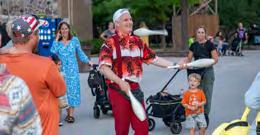


Sponsored by WaterStone Bank
5-8:30 p.m.
No matter what your age is, there’s nothing quite like a trip to the Zoo to make you feel like a kid again. Zoo Pass and Platypus Circle members will get the chance to bring their kids — and their inner child — to an exclusive event to celebrate the fun and joy of summer and the Zoo.
Watch performances by Main Street Song & Dance Troupe, Kip’s Fun Show and music by Reilly. Along with the live music, be sure to keep an eye out for Wild Willy performing his juggling act while strolling throughout the park.
Purchase dinner from a variety of food trucks and vendors throughout the Zoo. Participating food trucks will donate 15% of their proceeds to the Sponsor an Animal program. Food can also be purchased at the Zoo’s concession stands and food trucks.
Members are invited to one of three nights during the event (Invitations were mailed in May). If you are invited on a day that is inconvenient, please feel free to come on one of the other evenings.
We value your relationship with the Zoological Society of Milwaukee. The Society does not sell member/ donor information to third parties, but may share limited information with the Milwaukee County Zoo for the purpose of confirming membership status.
Zoological Society office hours:
9 a.m.-5 p.m. through Sept. 2
Zoo hours: 9:30 a.m.-5 p.m. through Sept. 2
Note: The Zoo’s admission gates close 45 minutes prior to the posted Zoo closing time. The animal buildings close 15 minutes before posted Zoo closing hours. Many outdoor animals are brought in 45 minutes prior to Zoo closing.
Company picnics: For members visiting the Zoo with a company picnic, Zoo Pass members’ free admission or free parking benefits do not apply. The fees paid for company picnics include admission and parking and usually include additional Zoo-visit benefits.
Problems renewing or transacting online: If you experience any difficulties transacting a Zoo Pass renewal or animal sponsorship online, please contact us at 414-258-2333 so we can assist with your transaction. Our staff is available seven days a week.
Reciprocal zoos and aquariums: We update our list of zoos and aquariums that offer reduced or free admission to our members with the Association of Zoos & Aquariums in spring each year. We only reciprocate with AZA-accredited facilities and reserve the right to not reciprocate with zoos and aquariums located within close proximity of the Milwaukee County Zoo. Please contact the facility you are visiting before arrival to ensure reciprocity.
Moving? Please call us when you change your address or name. The call saves us money because when the Post Office returns your mail with a forwarding address, we pay twice for mailing: to the old address and the new.
Zoo admission: Please remember to have your Society Zoo Pass and identification ready when you arrive at the Zoo’s admission gates. If you’ve misplaced or lost your card, replacement cards may be purchased for $5. Zoo Pass admission is valid for regular daytime Zoo hours and many events.
Who can use member cards? The person(s) named on the Zoo Pass is the owner of the card and benefits are not transferable to anyone else. We need to have the number of members’ minor children/ grandchildren in your household reflected in your membership records for the Zoo’s admission gates. Foster children are covered on your membership. Your Zoo Pass membership does not cover children for whom you provide baby-sitting or day-care services. The Society and the Zoo retain the right to invalidate any membership being used inappropriately.
Guests can also receive a ticket for one free ride on the Penzeys Carousel (redeemable only during Kids Nights). Make sure to visit any WaterStone Bank branch from now until July 6 and show your Zoo Pass to get a ticket. One free ticket per Zoo Pass membership.

Looking for the perfect thing to hang up on your wall?
How about a colorful painting from the Zoo’s North American river otter, Shamrock?
This summer’s limited-time offer sponsorship package is for Shamrock. A $50 sponsorship comes with a print of an original Shamrock “otter-work,” along with a certificate of sponsorship, an invitation to a behind-the-scenes event in August* and more! A sponsorship at the $100 level also includes an otter photo and two Zoo attraction coupons.

Did you know the Zoo’s otters paint as part of their enrichment?
Issue No. 168, July-Aug 2024
Wild Things is a membership newsletter published by the Zoological Society of Milwaukee five times a year.
Editor & Writer: Michael Grennell
Contributing Writer: Carolyn Lewis
Designer: Kevin McIntosh
Photos taken by Carolyn Lewis unless otherwise noted.
Contact the Zoological Society at: 10005 W. Bluemound Rd., Milwaukee, WI 53226 Phone: 414-258-2333

There’s also a special treat with this offer. Anyone who purchases the limitedtime offer sponsorship will be entered into a drawing to win the original painting! The drawing will take place after the offer ends on Aug. 31. Animal sponsorships can make great gifts for any occasion. To order one today, to purchase.

We know that the stars of the habitats at the Milwaukee County Zoo are animals. Have you ever watched a grizzly bear, flamingo or tiger and wanted to learn more about them? That’s what their interpretive signs are for!
This summer, take a moment to walk slower and enjoy the new outdoor metal signs installed by the Zoo’s maintenance team and redesigned by the Zoological Society’s creative department. Emily Salentine, interim marketing and communications director at the Zoo, shared her thoughts on the project: “We hope guests will discover even more about the animals through these new signs, so they’ll have a greater appreciation for the animals in our care and, in turn, help us to protect them.” Approximately 115 signs
were reprinted with enhanced visibility in mind. The signs feature larger fonts and sizes and, in some areas, they are mounted on rails to ensure visibility for everyone, including children and those with mobility needs.
“We’re excited to see the public’s reaction and hope the new signs will have a positive impact on guest
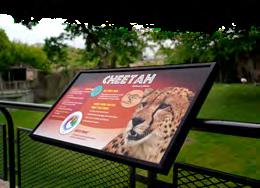
Don’t throw out that box or bottle just yet. What you may see as trash could instead become part of a creative masterpiece!


This year’s Kids Green Art Contest is all about our favorite scaly or slimy animals that can be found at the Aquatic & Reptile Center. The contest is open to kids ages 17 and under, and projects will be publicly displayed on Aug. 24 during the Animal Safari event and virtually on the Society’s website after the event.
Go to zoosociety.org/greenart to register and learn more about the contest.
Dates to Remember:
Register by Aug. 9
Deliver artwork between Aug. 17-23
Artwork displayed Aug. 24
Winners notified the week of Aug. 26


Wisconsin weather can keep us on our toes; should we wear shorts or pants, a raincoat or a sunhat? For camels, a woolen coat that they grow at the end of summer keeps them fluffy and warm in the winter. But, unlike a jacket, they cannot choose when they wear it! Instead, they shed in the spring to prepare for warmer weather, losing their dense undercoat in place for a more breathable, wiry coat. The shedding process does not bother the camels, but they may be spotted rubbing up against trees in their habitat to help loosen the fur.


supervisor at the Milwaukee County Zoo. Both AJ and Leilani are halter trained for this process. Leilani, who just turned one year old this spring, was brushed out by the animal care team and did a great job for her first groom.
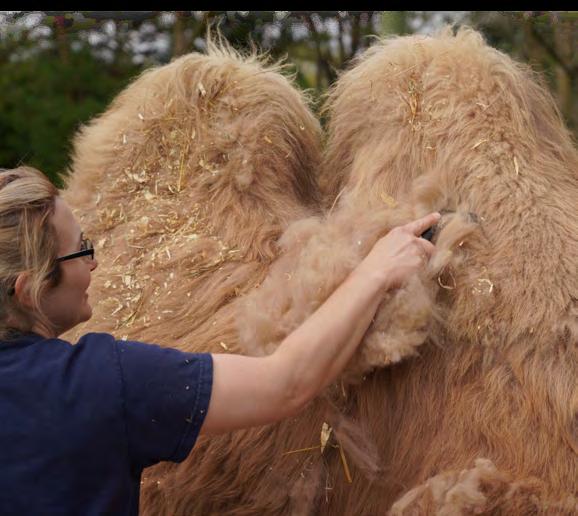
 Losing all that coat is not an overnight process. For example, Stan, the male Bactrian camel, gets quite shaggy!
Losing all that coat is not an overnight process. For example, Stan, the male Bactrian camel, gets quite shaggy!
What’s the first thing that comes to mind when you think of bees? It’s probably also what you think of when thinking about bears. Honey is the sweet, sticky bond between bears and bees both out in the wild and at the Milwaukee County Zoo.
The Zoo has been host to bee colonies for more than six years now, with the newest group arriving at the Zoo from a local bee supplier in April. Roughly 7,000 bees were installed in the Zoo’s hives this year, and according to Conservation Manager, Auriana Donaldson the population of the colony could rise to almost 100,000 at its peak this summer.
“The beehives are an excellent education tool for Zoo guests and in


our Conservation Education summer camps and classes,” Donaldson said.
“Honeybees are just one of the many animal pollinators that we depend on for food in the United States. One out of every three bites of food that we eat was pollinated by animals.”
Along with being an excellent source of education, the beehives are also — of course — an excellent source of honey. According to Donaldson, the beehives at the Zoo produce on average 40 to 60 pounds of honey each year. She adds that 20 to 30 pounds of honey are left in the hive for the bees to eat over winter to survive. That leaves plenty of honey left over for the bears to get some to eat!
“We got permission a couple of years ago when they were collecting honey from that hive to give it to our bears,” Dawn Fleuchaus,

Did you know?
Honeybees are not native to the United States. They originated in Africa, Europe and Asia, but were later introduced to North America, South America and Australia. Now they play a key role in our agricultural systems thanks to their efficiency as pollinators!

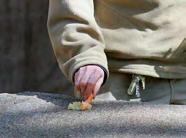

North America area supervisor, said. “When they collect it, it’s got pieces of comb mixed into it, so it’s a different component than just using honey out of the bottle — it’s a little bit different taste; it’s fresher.”
Fleuchaus said that they use honey (and sometimes peanut butter) to help give the bears medication as well as provide enrichment for them. By leaving bits of honey around the habitat, it lets the bears use their strongest sense — smell — to hunt for the delicious honey.
The bears — much like us when it comes to candy — don’t get the honey every day. Fleuchaus says that she and her team don’t want to make having honey a predictable routine for the bears and instead keep it a special, once-in-a-while

food. The keepers also make sure they place enough honey around the habitat for all the bears to enjoy (mama grizzly bear, Ronnie, gets a few dabs of honey placed around her favorite rock near the Elk habitat) and to avoid any aggressive behaviors over competition for the honey.
“We would really use it to try and challenge them to obtain it and make them spend some time working to get it,” Fleuchaus said. “So we’ll maybe drizzle a tiny little trail all along the whole habitat that they have to follow and lick up, or put little dabs here and there so they’re having to use their sense of smell to locate it and use their tongue to get it out of crevices or out of toys or other feeders.”
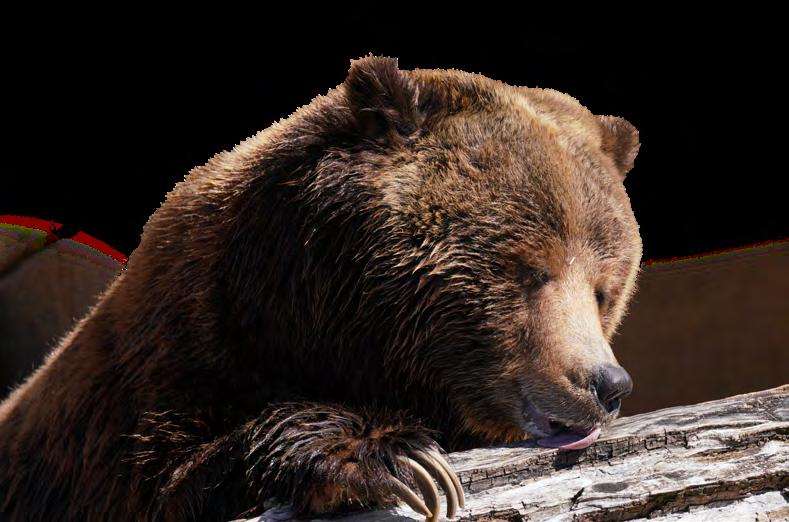
So when you next visit the Zoo, make sure to check out the bears and see if they’re getting honey — watching them search for the honey is almost as sweet a treat as it is for them to eat!

The summer performance season is well underway at Kohl’s Wild Theater. In case you haven’t stopped by yet, here’s what you’ve been missing out on!
“The Time Traveler’s Chicken” — Take a wacky but poignant trip throughout time, exploring the relationships between Earth’s creatures and conservation actions of the past and present.
“Rear Hippo” — Lights! Camera! Mystery!
An Alfred Hitchcock-inspired musical mystery, the show will look at symbiosis in nature and how important it is — however
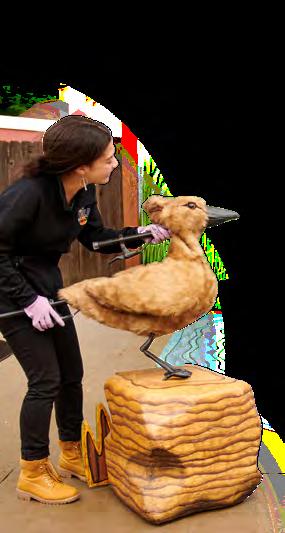
guests will both collect and return their completed playbills Tuesday through Sunday between 11:15 a.m. and 2 p.m.
Guests must attend one KWT show and two Zoo events (“At-Habitat” encounters with Paxton the Penguin, the Zoo Pride biofact cart, Animals in Action talks or Animal Encounters), or attend two KWT shows and one Zoo event and then answer the questions on the back of the playbill.
Once completed, guests can receive a free ticket to ride the North Shore Bank Safari
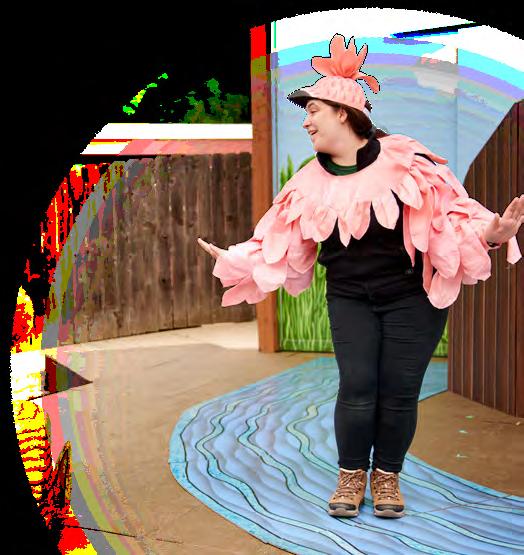
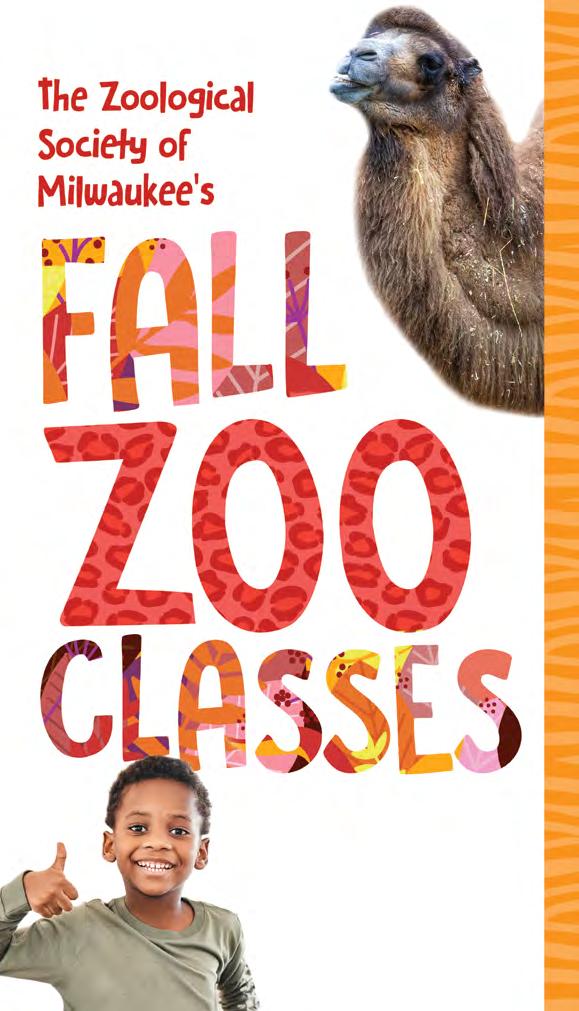
We know you’re excited about our classes, and we want to make your child’s educational experience rewarding. Please read and familiarize yourself with important information and policies on the last page.

building. Tours take place outside rain or shine.
Let’s stroll through the Zoo to find animals with horns, hooves and humps! Practice stomping your bongo hooves, pretend to “ride” the humps of the Bactrian camel and play “peek-a-boo” as you look for the oryxes’ horns.
8:45-9:45 a.m.
Oct. 3, 4, 6, 8, 9, 12, 17, 22, 25
10:15-11:15 a.m.
Oct. 4, 6, 8, 9, 12, 17, 25
See bumpy alligators, slimy fish and scaly snakes as we venture through the Aquatic & Reptile Center. Explore the topic of textures with your little one as we learn songs, rhymes and sign language for these animals that you can practice at home.
8:45-9:45 a.m.
Dec. 4, 5, 6, 10, 17, 18, 19, 21, 22
10:15-11:15 a.m.
Dec. 6, 10, 17, 18, 19, 21, 22

$30 Zoo Pass members
$40 non-members with one adult
Join us in our indoor/outdoor classroom to learn about trains. We’ll explore a variety of shapes as we build a train costume. We’ll practice our train sounds as we read a train book. Then we’ll chug on over to ride the train around the Zoo together. All aboard! Choo! Choo!
8:45-9:45 a.m.
Sept. 18, 19, 20, 21, 22, 25, 27, 28, 29
Oct. 1, 3, 4
10:15-11:15 a.m.
Join us as we swing over to see the gorillas, orangutans and spider monkeys. Let’s find out how these primates use their hands, feet, fingers & toes (and sometimes tails!) to eat, move and play. Sing a song to practice body part identification with your primate baby.
8:45-9:45 a.m.
Oct. 31
Nov. 1, 5, 8, 10, 12, 13, 14, 16, 17
10:15-11:15 a.m.
Nov. 1, 8, 10, 14, 16, 17
“This is the best day ever!” ~ class participant
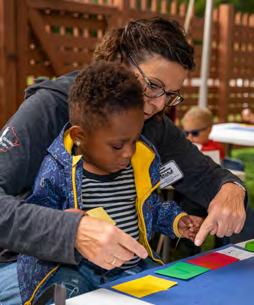
Sept. 20, 21, 22, 27, 28, 29
Oct. 3, 4
Crawl into our pond classroom and immerse yourself in the world of turtles. Decorate your own turtle costume and practice hiding in your shell. Play a game with pretend turtles in our sand and water table. Afterward, we’ll meet one of the Zoo’s turtles!
8:45-9:45 a.m.
Nov. 20, 22, 23
Dec. 3, 8, 12, 14, 15
10:15-11:15 a.m.
Nov. 22, 23
Dec. 8, 13, 14, 15, 18
$37 Zoo Pass members $47 non-members with one adult
Swoop into our nighttime classroom to learn about bats. Use a flashlight to explore the bat cave, practice sleeping “upside down” and make a bat costume, complete with wings. Then we’ll fly to the Small Mammals Building to watch these nocturnal mammals in action.
8:45-10:15 a.m.
Oct. 10, 11, 16, 18, 26, 27, 31
11 a.m.-12:30 p.m.
Oct. 11, 26, 27, 31
Here, fishy, fishy! Come to our underwater classroom to learn about our finned friends. Decorate a fish costume and pretend to swim through “water.” We’ll dart as a school of fish over to the Zoo’s Aquatic & Reptile Center to see some fishy friends up close. It will be a swimmingly good time!
8:45-10:15 a.m.
Nov. 7, 8, 9, 13, 15, 16, 17
11 a.m.-12:30 p.m.
Nov. 8, 9, 16, 17
Spy monkeys and apes among the tall trees in our rainforest classroom. Knuckle-walk like an ape or swing like a monkey in search of food. Make your own binoculars and use them to discover the difference between a monkey and an ape as we trek through the Primates of the World Building.
8:45-10:15 a.m.
Dec. 5, 6, 8, 11, 14, 20, 22
11 a.m.-12:30 p.m.
Dec. 6, 8, 14, 22
$45 Zoo Pass members
$55 non-members child only or with one adult
Sign up your child for a child-only class or attend with your child in a with adult class.
Nocturnal animals have sharp senses. Can you smell as well as a bush baby, see as well as an owl or hear as well as a fennec fox? Put your senses to the test in our nighttime classroom before we creep over to see nocturnal animals at the Small Mammals Building.
Awesome alligators, super snakes and terrific turtles — find out what makes these animals special! Turn into an alligator, create your own snake that “sheds” and build an alligator nest. Then slither over to the Aquatic & Reptile Center to see these creatures in action.
$45 Zoo Pass members
$55 non-members child only
Bear with us as we journey into the captivating world of bears! Learn which kind of bear has an 8-inch tongue and which is missing its two front teeth as we visit the Zoo’s bears and learn about others from around the world! Discover how our grizzly bear family came to the Zoo — and what to do if you come across one in the wild. Don’t miss this beary exciting adventure.
9:15-11:45 a.m. Ages 6 & 7
9:15-11:30 a.m.
Sept. 19, 20, 21, 22, 24
Oct. 2, 6, 11, 13, 18
9:15-11:30 a.m.
Oct. 24, 25, 26, 27, 30
Nov. 1, 3, 7, 9, 10 Oct. 27
1-3:15 p.m. Nov. 3, 10
Oct. 6, 12, 27
1–3:30 p.m.
13, 26 9:15-11:45 a.m.
Artists assemble! We have an important job to do! After learning about really cool fish that call the ocean home, we will tour the Aquatic & Reptile Center to catch some of these fish in action. Then, we will use our knowledge to create art that inspires others to protect these amazing aquatic animals!
Ages 6 & 7
9:15-11:45 a.m.
Nov. 3, 9, 24
1–3:30 p.m.
Ages 8 & 9
9:15-11:45 a.m.
Nov. 10, 23
1–3:30 p.m.

13, 27 1–3:30 p.m.
Daring adventurers, get ready to explore the coldest, driest and windiest place on Earth! Discover how animals survive in the icy desert we call Antarctica – without any jackets, hats or gloves! Don’t be left out in the cold!
Nov. 3, 10, 16, 24
Nov. 9, 23


$100 Zoo Pass members $120 non-members child only
Become a wild learner in our four-week-long, once-a-week series. Classes will develop curiosity, create empathy and encourage healthy social skills. With the same students each week, we’ll build community as we explore and learn together.
Join us for Roaring Careers where you’ll discover the amazing jobs people do at the Zoo! From taking care of animals to teaching others about them, there’s so much to explore. Meet real zoo workers, go behind the scenes and find out what it takes to have a wild job helping animals every day! Choose the AM or PM session.
10-11:30 a.m.
Oct. 10, 17, 24, 31
1-2:30 p.m.
Welcome to Reptile Rendezvous! Get ready for an amazing adventure into the world of reptiles! In this class, we’ll meet slithery snakes, cool lizards and more. We’ll learn about their superpowers, like how they crawl, climb and camouflage. Join us for a wild and wonderful journey into the exciting world of reptiles! Choose the AM or PM session.
1-2:30 p.m.
While we welcome family members of all ages, the content of this class is intended for children ages 3-14. Minimum of two registrants required and must include one adult (18 years or older) and one child. Children under the age of 1 are free to attend and do not need to be registered.
$30 non-members all ages
$20 Zoo Pass members
Slimy, stinky, snotty, scary – animals can be monstrous and terrifying when they want to be. Let’s dive into the world of monsters, venture into the Zoo and learn what adaptations make animals scary and conquer our fear of the unknown! We’ll change icky to awesome and terrifying to terrific!
9:15-11:30 a.m.
Sept. 29 Oct. 12
Sept. 28, 29 Oct. 12, 26 1-3:15 p.m.
Have you ever chased a firefly on a summer night? Fireflies aren’t the only creatures that glow. There are other creatures that light up the forest and ocean. These lights come from bioluminescent (or glowing) creatures! Be enlightened as you investigate why some animals glow. Discover how these creatures glow and create a radiant creature of your own. Don’t miss this illuminating class!
9:15-11:30 a.m.
1-3:15 p.m. Oct. 10, 17, 24, 31
Nov. 16
Dec. 22
Nov. 14, 21 Dec. 5, 12 10-11:30 a.m. Nov. 9, 16 Dec 21, 22
Nov. 14, 21 Dec. 5, 12
A STORY OF SYMBIOSIS
You may not make it if I’m a parasite, but if we’re commensal we won’t fight. Just the two of us — it’s symbiosis! In this class learn about the unique relationships some animals have with each other in order to live!
9:15-11:45 a.m.
Help dig up the past as we solve the mystery about one of the MOST famous fossils: Archaeopteryx. Solve the clues to help scientists finally decide if it’s a bird or a reptile. Explore the Zoo to examine clues that can guide us to the answer!
Try out a 1 -hour Family Class as part of your Zoo Day!
$15 Zoo Pass members
$25 non-members all ages
$45 Zoo Pass members $55 non-members child only Nov. 24
9:15-11:45 a.m.
How do certain animals end up in zoos? Why do genetics matter in conservation? How can people in Milwaukee support global conservation and reduce conflict between humans and wildlife? Learn about Pat, a jaguar from Belize, and how his story can help us answer these questions.
In English
9:15-10:15 a.m. Nov. 24 10:45-11:45 a.m.



¿Cómo terminan ciertos animales en los zoológicos? ¿Por qué la genética es importante en la conservación?¿Cómo puede la gente de Milwaukee apoyar la conservación global y reducir los conflictos entre los humanos y la vida salvaje? Conozca a Pat, un jaguar de Belize, y cómo su historia puede ayudarnos a responder estas preguntas.
1-2:00 p.m.
Nov. 24

2:30-3:30 p.m.
Nov. 24

Member online registration begins July 17 at 9 a.m.
Non-member registration begins July 24 at 9 a.m.
Financial Aid available to those who qualify

• Participants must be the appropriate age for a given class and no unregistered children may attend (including siblings). Exceptions on age are only made for children with special needs (please call Education prior to registration).
• If your child is attending a child-only class, an adult (18 years or older) must check the child in and provide the following information: emergency phone number, allergies/medications and names of adults authorized for pickup.
• Only authorized adults with valid identification may pick up children.
• In addition, please do not meet or follow your child’s group into the Zoo, as this is a distraction to the educational experience.
The time required to enter the Zoo can vary greatly. Please plan to arrive early and check your confirmation email for entry instructions. Thank you for your patience and understanding!
You Cancel – If you’re unable to attend class, call at least 3 days before the class date and we will try to reschedule your child for another available date this season. We do not issue refunds; however, you can offer your child’s class to a friend of the same age.
We Cancel – The Conservation Education Department reserves the right to cancel classes. We will attempt to reschedule, accommodate your child in another class, or process a reimbursement. For weather-related cancellations, refer to local news stations or 414-258-5058

A La Carte at the Zoo Presented by Meijer
Thursday-Saturday 9:30 a.m.- 9 p.m.; Sunday 9:30 a.m.- 8 p.m.
Get in the mood for some good food at the Zoo. A La Carte at the Zoo is a fourday culinary extravaganza, featuring restaurants from around Southeastern Wisconsin .along with live entertainment from national and local acts.
Guests will have plenty of food options to choose from. Prepare yourself for bites both sweet and savory, as A La Carte will feature food from Nothing Bundt Cakes, Catalano Corn, Saz’s, Shawarma House, Scrima’s Pizza, Thunder Bay Grille, Tots on the Street and more! And make sure you don’t miss out on live entertainment at the Lakeview Stage, sponsored by Renewal by Anderson, and at the Woody Stage, sponsored by Mad City Windows & Baths.
Zoo Pass and Platypus Circle members receive free admission to the event.



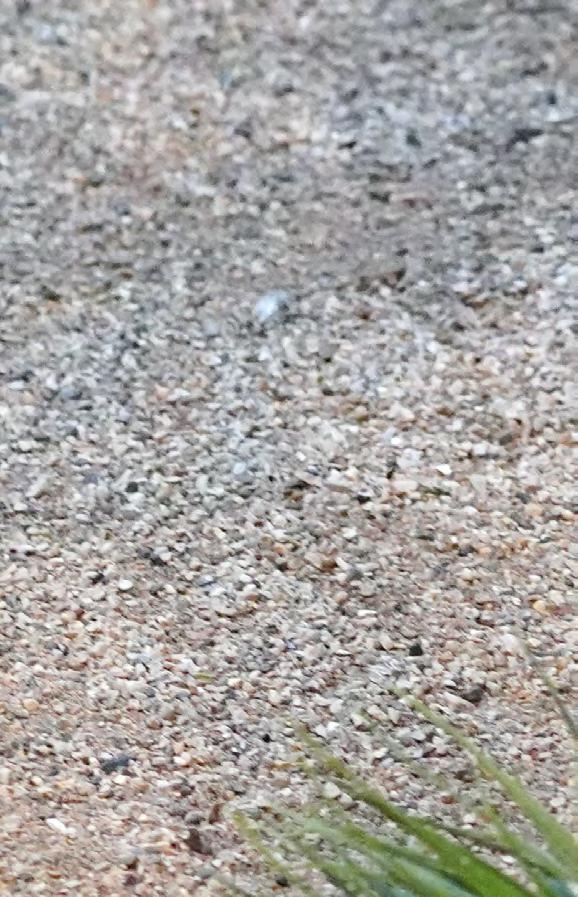
When you walk into the Herb and Nada Mahler Family Aviary at the Zoo, you’ll get to see dozens of species of birds as you walk through the building. Some are big. Some are small. Some are dark in color and others have bright and vibrant plumage.
Stopping at the Kopje habitat, your eyes will probably be drawn towards the redbilled hornbills and their striking, curved beaks perched up on a branch. One might easily overlook the Zoo’s young male crocodile bird hopping about on the sandy ground.
Also known as the Egyptian plover, according to the International Union for Conservation of Nature they are listed as a species of Least Concern. Paradoxically, although crocodile birds are plentiful in the wild, they are very rare in North American zoos. Aviary Curator Alex Waier said that there are currently only 14 crocodile birds located at four organizations in North America. Three of those birds currently live at the Milwaukee County Zoo, and a fourth bird at another organization was hatched here before finding a new home.
“There have never been very many however (in North American Zoos), as they are difficult to successfully
to successfully mimic the process by putting the eggs in an incubator with sand.
The youngling celebrated his first birthday back in March and is already living on his own in the Kopje habitat. But he’s not too far away from his parents, who live next door in the Termite habitat.
The next time you visit the Zoo, be sure to stop by and be one of the few people in North America who get the chance to see a crocodile bird in person.
The crocodile bird got its name from a supposedly symbiotic relationship it has with crocodiles. The Greek historian Herodotus wrote that Nile crocodiles would lie on the shore with their mouths open and the crocodile birds would fly in and feed on debris and parasites lodged between the crocodiles’ teeth. Despite the fact this behavior has never been proven true, the name has stuck ever since.
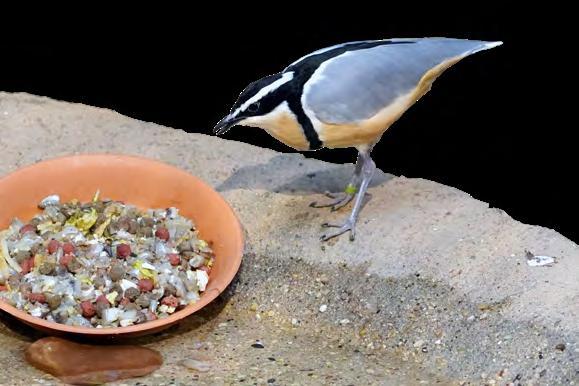
You have plenty of decisions to make every day, so why not let us make a decision for you? With our new mystery Sponsor an Animal package, we’ll pick the animal for you to sponsor! This is a perfect way to learn more about an animal that you may not have thought about before.
This new offer comes at two sponsorship levels: The $45 package comes with a certificate of sponsorship, animal fact sheet, Sponsor an Animal decal, a year’s subscription to Alive magazine and Wild Things newsletter, name recognition and invitation to a behind-the-scenes event in August.* For just $5 more, upgrade to the $50 package and receive a surprise plushtoy animal in addition to the benefits from the $45 level!
This mystery Sponsor an Animal package is available year-round, making it a perfect gift to give for any occasion. To order one today, visit: zoosociety.org/SponsorAnimal or call 414-258-2333.
*Animal Safari is a behind-the-scenes event for animal sponsors. The tours are predetermined and may not be related to the animal you sponsor.
AUG 24
Animal Safari Tours run 10 a.m.-3 p.m.
Whatever animal you support — whether it’s big or small, scaly, furry or feathery — the Zoological Society greatly appreciates the generosity in helping keep our animals safe, happy and healthy. Now it’s time to thank their sponsors with an exclusive event just for them.
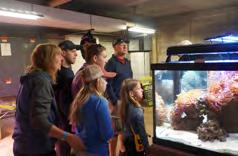
Animal Safari will feature behind-the-scenes tours*, animal talks, examples of animal enrichment, animal-themed crafts and more. This is our way of saying thanks to all who have sponsored one (or more!) of the animals throughout the Milwaukee County Zoo.
Look for your invitation in the mail. Not an animal sponsor yet? You can sponsor an animal on the day of the event and still take part in the tours, or you can sponsor an animal today at zoosociety.org/SponsorAnimal. Sponsorship packages start as low as $25.
*Tours are not necessarily in the area of your specific sponsored animal.
Photo by Michael GrennellTake a step back hundreds of millions of years into the past at the Milwaukee County Zoo’s summer exhibit: Dinosaur Discovery, sponsored by Sendik’s Food Market. Open now through Oct. 5, guests will see more than a dozen life-sized dinosaurs that stalked the Earth from the Permian period through the Cretaceous.
Before you stomp your way alongside these prehistoric predators, get a sneak peek at some of the dinosaurs you can visit this summer at the Zoo.
Dimetrodon: Quadrupedal carnivore
• Name means “two measures of teeth,” because it had a large skull with two types of teeth — shearing and sharp.
• Measuring 7 feet tall and weighing around 550 pounds, dimetrodons are distinctive thanks to a large spiny sail on its back that was likely used to help regulate its body temperature.
• Lived across North America during the early part of the Permian period — roughly 25 to 50 million years before the start of the Triassic period.
• Not a dinosaur! — Despite its appearance closely resembling dinosaurs, the dimetrodon was not a dinosaur. In fact, it is more closely related to mammals, which is why it’s referred to as a protomammal.
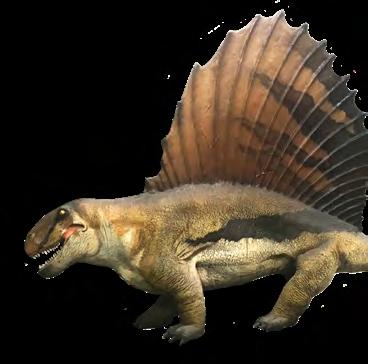

Was the largest and most successful predator
Lived during the late Jurassic period in North America, mostly found in modern day Utah, Colorado and Wyoming.
Name means “different lizard” because its vertebrae were different from those of other dinosaurs that had already been found at the time of the allosaurus’ discovery. They were hourglass-shaped with hollow spaces that contained air sacs — just like the vertebrae in modern birds!
One of the largest dinosaurs found in the southern hemisphere, hence its name meaning “Giant Southern Lizard.”
Lived during the Cretaceous period in modern-day Argentina.
Standing 12 feet tall, 44 feet long and weighing about 8 tons, it was larger than the Tyrannosaurus rex.
Had an enormous jaw filled with 8-inch-long serrated teeth.
Seem familiar? The giganotosaurus was one of the featured dinosaurs in the 2022 film,
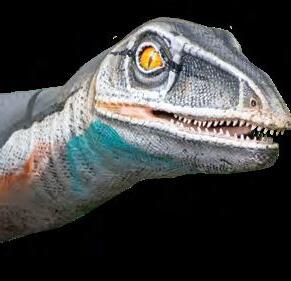
Coelophysis: Small but fast
Was a bipedal carnivore in the Triassic period. Lived in the modern-day Southwest region of the United States in Arizona, Colorado and New Mexico.
• Name means “hollow form” because of its hollow limb bones.
• Was a small dinosaur — averaging about 3 feet in height and about 50 pounds — but very fast, and its sharp jagged teeth, three claws on each hand and speed made it an excellent predator.


e see wildlife around us often, whether it’s birds, squirrels, rabbits or other animals. As we watch them hop, fly or scurry around us, we can see how they are affected by the presence of humans. In Belize, it can sometimes be more challenging monitoring wildlife activity — especially at night. But a camera trapping program has helped give conservationists the chance to study the wildlife in Belize, thanks in part to the help of local farmers.

The main goal of both the Milwaukee County and the Belize programs is to learn more about the wildlife that lives among us. The understanding gained from these conservation programs can help humans and animals to coexist safely and respectfully. And most of all, both programs rely on the efforts of community members to help make a difference!
Support conservation in Belize! One of the ways in which the Pat Gives Back program helps conservation efforts in Belize is by covering the annual salary for Chiac’s position. Without Chiac, the camera trapping program would not exist!
Check out zoosociety.org/patgivesback to learn more about how to help support this and other conservation efforts.


Wildlife officer Florentino Chiac at the Ya’axché Conservation Trust runs a program in which cameras have been placed at 19 farms across nine communities to better understand the distribution and relative abundance of animal species in the area, and how human activity has influenced their activity patterns. This citizen science program has helped farmers gain a better understanding of and appreciation for the wildlife that roams around their land.
While the wildlife and the landscape between here and Belize may be different, that doesn’t mean there aren’t also important citizen science programs you can participate in here in Milwaukee County. For example, the Milwaukee County Coyote Watch is a useful tool for managing coyote population in urban areas. Since researchers can’t be everywhere at once, gathering data from community members is important to be able to track where coyotes have been seen, high-traffic areas and any conflicts between humans and coyotes that may occur.


Ride on the Wild Side Sponsored by Lifeway Foods

Grab your helmet and get ready to go biking by bears and cruising by caribou. Ride on the Wild Side is the one time each year you get the chance to ride your bike through the Zoo. Take a nice leisurely ride on the family-friendly 2.5-mile route, or push yourself with the 10-, 17- or 27-mile routes. All riders will receive a long-sleeved T-shirt, breakfast, lunch and a day at the Zoo. Electric bikes and bike trailers are permitted at the event. Zoo Pass members:
Zoo Pass members*:
Adult (age 14+): Child (age 3-13)
Now until July 31 - $40 Now until July 31 - $20
Aug. 1 until Sept. 4 - $50 Aug. 1 until Sept. 4 - $25
Day of Event - $60 Day of event - $30
*Members must log in to their Zoo Pass account in order to receive member pricing.
Non-members:
Adult (age 14+): Child (age 3-13)
Now until July 31 - $55 Now until July 31 - $30
Aug. 1 until Sept. 4 - $65 Aug. 1 until Sept. 4 - $35
Day of Event - $70 Day of event - $40

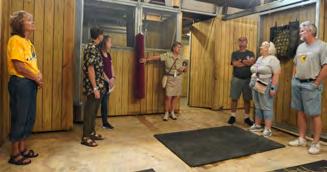
Sponsor an animal and get an invitation to our behind-the-scenes event, Animal Safari. Read more on page 11.
Now-Sept. 2
Kohl’s Wild Theater’s summer season at the Zoo with free shows every day except Mondays* Now-Oct. 5
Special summer exhibit, Dinosaur Discovery, sponsored by Sendik’s Food Market
June 30
Military & Veterans Family Day at the Zoo*
July 4
$4 on the Fourth*
July 9, 10 & 11
Kids Nights, sponsored by WaterStone Bank*
July 17
Member registration begins for Fall Zoo Classes.
July 22
Birdies & Eagles Golf Tournament, sponsored by GRAEF (pre-register)
Aug. 8, 9 & 10
Snooze at the Zoo, sponsored by Educators Credit Union (pre-register)
Aug. 9
Registration deadline for Kids Green Art Contest
Aug. 15-18
A La Carte at the Zoo, presented by Meijer* Aug. 24
Animal Safari, behind-the-scenes tours for animal sponsors Sept. 8
Ride on the Wild Side Bike Ride, sponsored by Lifeway Foods
*Zoo Pass members get free regular Zoo admission with their Zoo Pass. Those with Zoo Pass Plus also get free parking for one vehicle per membership per day. Platypus Circle members receive free admission and parking with their card.

